Running a Stepper Motor From an Adafruit HUZZAH ESP8266
by rgrokett in Circuits > Arduino
36200 Views, 60 Favorites, 0 Comments
Running a Stepper Motor From an Adafruit HUZZAH ESP8266
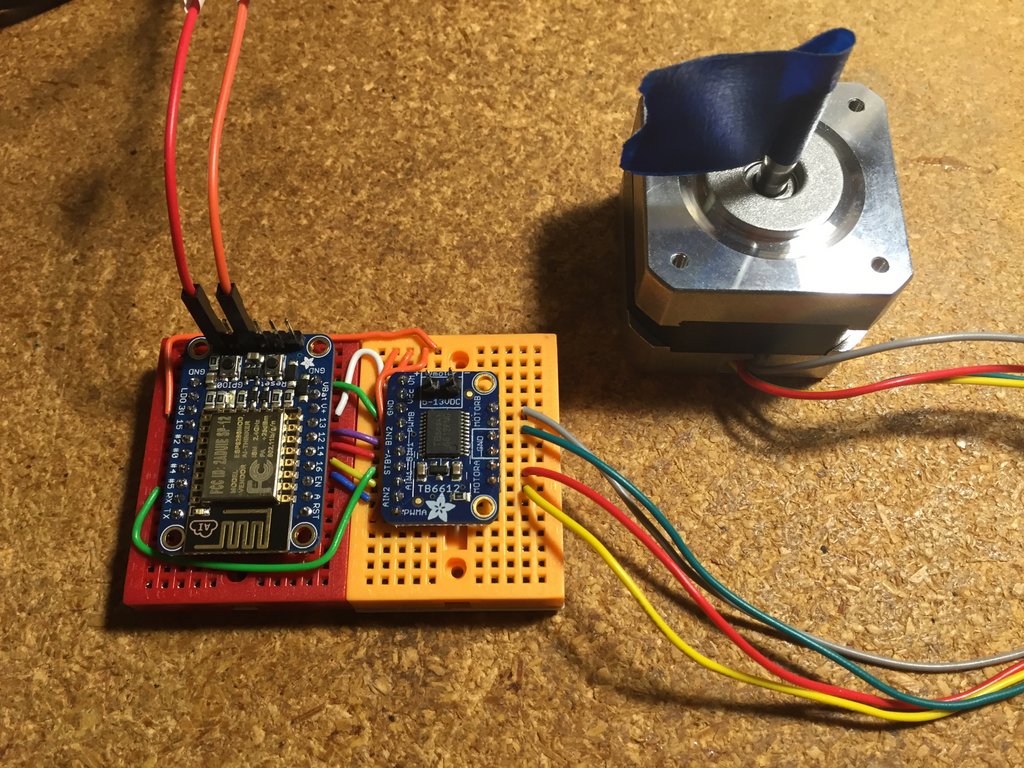
Overview
Surprisingly, you can run a powerful stepper motor (via motor controller) from the Adafruit Huzzah ESP8266 WiFi module and thus control the stepper via browser or web service, turning your stepper into an Internet of Things (IoT) device. This makes for a compact and low-cost remotely controlled motor, good for robots, mechanical arms and more.
Requirements
I used the following Adafruit components for the Stepper Motor and ESP8266 right out of the box. Otherwise, you would need to add regulators and related components to make the voltages compatible.
IMPORTANT NOTE! The power regulator on the Adafruit HUZZAH ESP8266 board has CHANGED. It no longer can handle 12v DC. A 5VDC power supply to feed the V+ and a 12v supply for the Stepper now required!
Older HUZZAH ESP8266's included a 3-16v regulator, so are unaffected.
Hardware
- Adafruit HUZZAH ESP8266 Breakout https://www.adafruit.com/products/2471
- Adafruit TB6612 1.2A DC/Stepper Motor Driver Board https://www.adafruit.com/products/2448
- Stepper motor NEMA-17 size 200 step, 12V 350mA https://www.adafruit.com/products/324 or equiv
-
12 VDC 1000mA power supply https://www.adafruit.com/products/798 or equiv
-
5 VDC 500mA power supply https://www.adafruit.com/products/501 or equiv
- FTDI or USB console cable https://www.adafruit.com/products/954 or equiv
- Breadboard, wire, etc.
Software
- Arduino IDE with ESP8266 extension package installed (see Initial Setup below)
- Download the ESP8266_Stepper web server app from GitHub https://github.com/rgrokett/ESP8266_stepper/
Important Initial Setup of Huzzah ESP8266
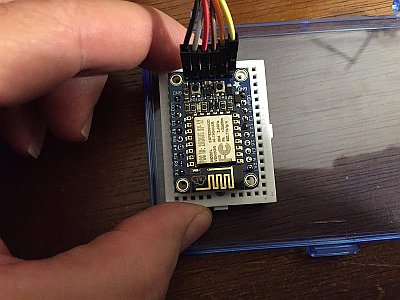
Before beginning the modification, you should become familiar with the Adafruit HUZZAH board and programming it using the Arduino IDE. The best way is to use the excellent Adafruit tutorial:
https://learn.adafruit.com/adafruit-huzzah-esp8266-breakout/overview
You must be able to program your ESP8266 and connect wirelessly to it via browser.
Once completed, THEN continue to next step.
Software
First you should program and test the ESP8266 before adding its hardware wiring:
- STOP! Be sure you have already completed the preliminary software setup of the Arduino IDE and tested the ESP8266 with your WiFi network as described in the Initial Setup above!
- Ok, download the ESP8266_stepper software from GitHub https://github.com/rgrokett/ESP8266_stepper/
- Copy the StepperWebServer.ino program to your Arduino library area.
- Using Arduino IDE, edit the StepperWebServer.ino and insert your SSID and PASSWORD into the appropriate places.
- Compile and Upload the program using the FTDI or USB console cable just like shown in the Adafruit tutorial.
- When the program finishes loading, open a Serial Monitor, set to 115,200 baud, and press the ESP8266 RESET button to restart the program running.
- It should display the IP address once connected to your Wifi.
Also, the onboard Red LED should blink 4 times signifying it’s successfully connected. - Use a browser to go to http://{your_ip_addr}/stepper/stop
This should respond back with “OK: MOTORS OFF” in browser
Go to http://{your_ip_addr}/stepper/rpm?1 and see “OK: RPM = 1”
Go to http://{your_ip_addr}/stepper/steps?10 and see “OK: STEPS = 10”
Go to http://{your_ip_addr}/stepper/start and see the onboard LED blink once
NOTE: If you have a Linux machine, you can use cURL to do these commands as well
- Unplug your ESP8266 and remove the FTDI/USB cable. It’s now programmed.
Hardware Wiring
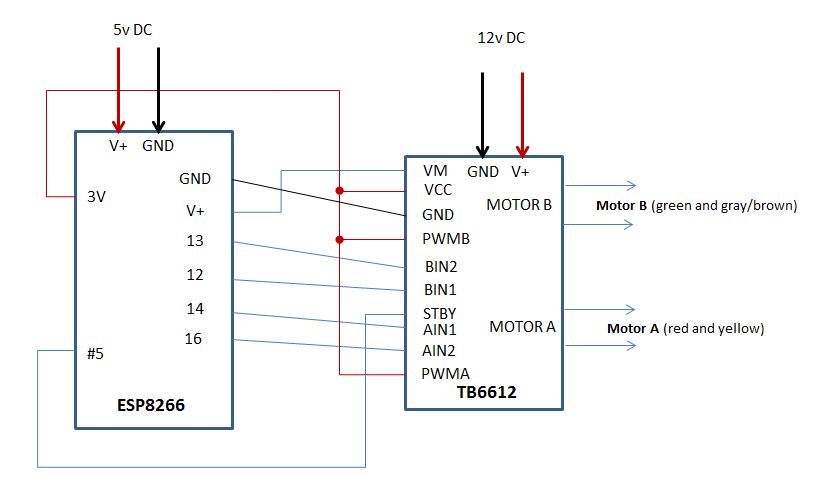


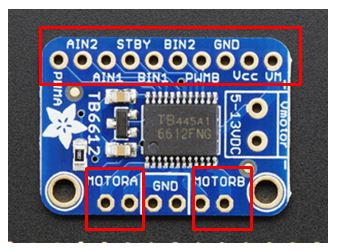
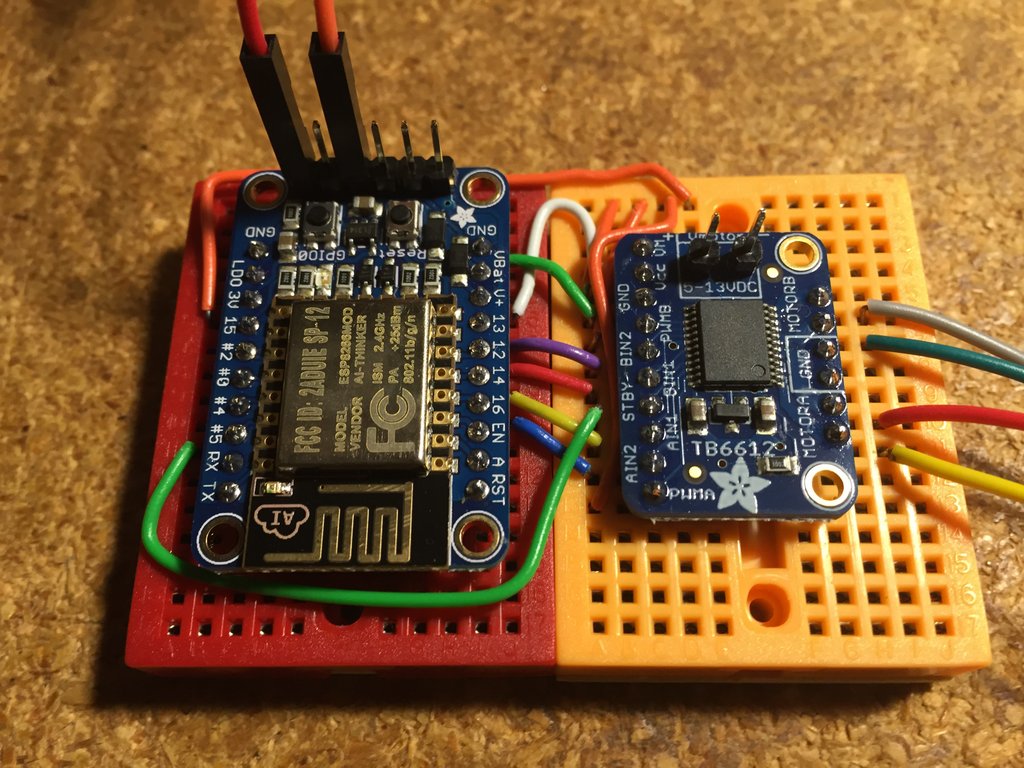
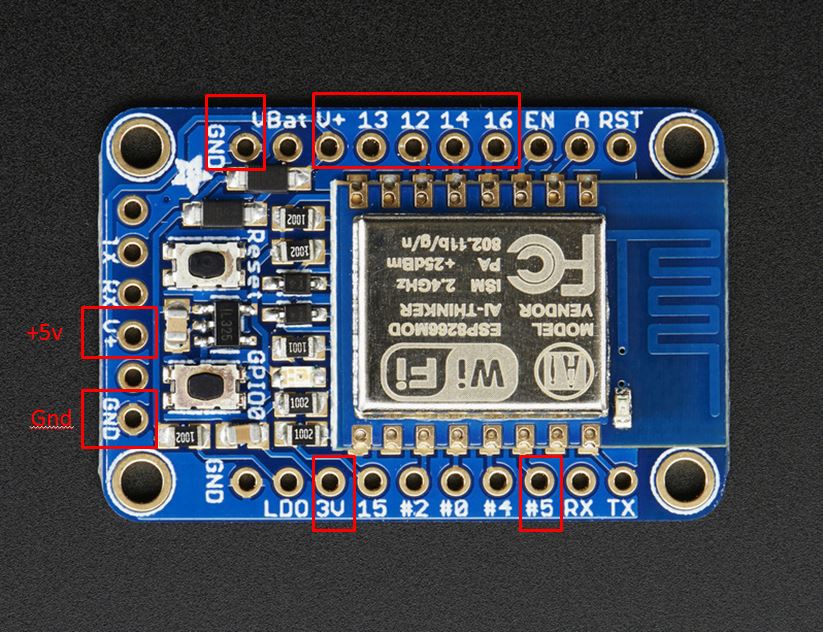
- Connect up the Stepper Motor to the TB6612 Driver board:
- Hook one stepper motor coil to Motor A (red and yellow)
- Hook the second coil to Motor B (green and gray/brown).
- Connect VMotor V+ to +12V Power
- Connect VMotor GND to 12V Ground
-
Next, wire up the Huzzah ESP8266 board to the TB6612 Driver board (see Wiring Table and Circuit diagrams)
-
Connect up the 5v DC power supply to GND and V+ pins on the side of the Huzzah board (same side that the FTDI USB programming cable connected to in the software load, above.)
NOTE ON POWER REQUIREMENTS:
If your power supply in insufficient, you could cause the ESP8266 to reboot repeatedly or not be able to drive the Stepper Motor.
Also, Steppers can get really hot w/o current limiting.
Be sure to send a “STOP” command (see below) to switch the TB6612 to standby which removes power from the Stepper. Use “START” command to reapply power.
Testing
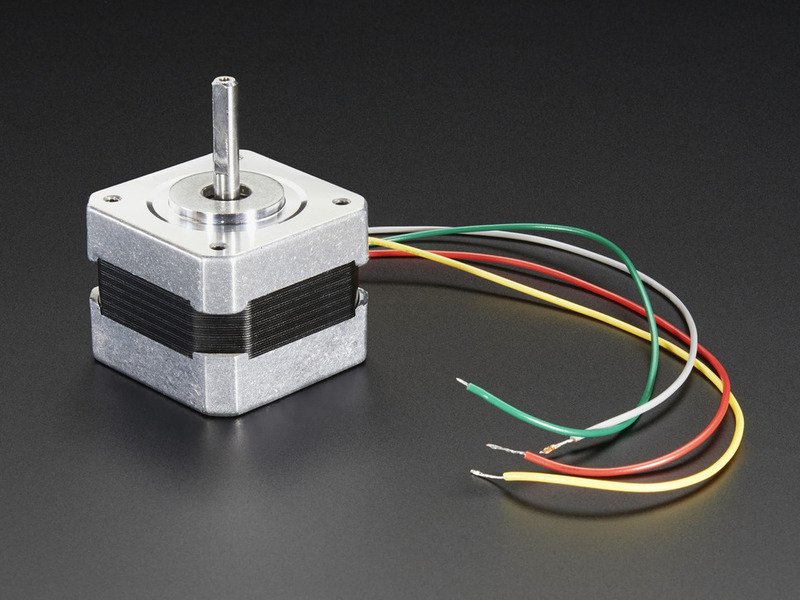
I used the built-in Arduino Stepper Library https://www.arduino.cc/en/Reference/Stepper to control the stepper motor. I added this to a simple HTTP control web server to provide remote control of the stepper.
Use a PC with web browser or Linux cURL command to try the functions below:
Functions available:
- http://{your_ip}/stepper/steps?5 -- Step 5 steps forward (values 1 to 200)
- http://{your_ip}/stepper/steps?-10 -- Step 10 steps backwards (-1 to -200)
- http://{your_ip}/stepper/rpm?6 -- Run at 6 RPM (1 to 50)
- http://{your_ip}/stepper/stop -- Stop the stepper motor (Removes power)
- http://{your_ip}/stepper/start -- Start the stepper motor (Restores power)
If you have a Linux machine (such as a Raspberry Pi) you can use the following simple automation example:
$ nano example.sh
Change ESP_IP to your ESP8266’s IP address.
$ bash example.sh
Have Fun!